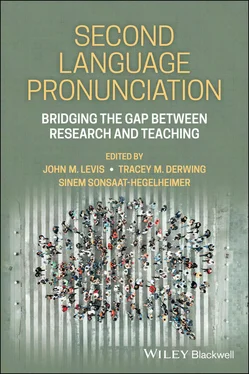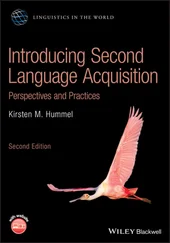Second Language Pronunciation
Здесь есть возможность читать онлайн «Second Language Pronunciation» — ознакомительный отрывок электронной книги совершенно бесплатно, а после прочтения отрывка купить полную версию. В некоторых случаях можно слушать аудио, скачать через торрент в формате fb2 и присутствует краткое содержание. Жанр: unrecognised, на английском языке. Описание произведения, (предисловие) а так же отзывы посетителей доступны на портале библиотеки ЛибКат.
- Название:Second Language Pronunciation
- Автор:
- Жанр:
- Год:неизвестен
- ISBN:нет данных
- Рейтинг книги:5 / 5. Голосов: 1
-
Избранное:Добавить в избранное
- Отзывы:
-
Ваша оценка:
- 100
- 1
- 2
- 3
- 4
- 5
Second Language Pronunciation: краткое содержание, описание и аннотация
Предлагаем к чтению аннотацию, описание, краткое содержание или предисловие (зависит от того, что написал сам автор книги «Second Language Pronunciation»). Если вы не нашли необходимую информацию о книге — напишите в комментариях, мы постараемся отыскать её.
Second Language Pronunciation: Bridging the Gap Between Research and Teaching
Second Language Pronunciation: Bridging the Gap Between Research and Teaching
Second Language Pronunciation — читать онлайн ознакомительный отрывок
Ниже представлен текст книги, разбитый по страницам. Система сохранения места последней прочитанной страницы, позволяет с удобством читать онлайн бесплатно книгу «Second Language Pronunciation», без необходимости каждый раз заново искать на чём Вы остановились. Поставьте закладку, и сможете в любой момент перейти на страницу, на которой закончили чтение.
Интервал:
Закладка:
Second Language Pronunciation
Bridging the Gap Between Research and Teaching
Edited by John M. Levis, Tracey M. Derwing, and Sinem Sonsaat-Hegelheimer

This edition first published 2022 © 2022 John Wiley & Sons, Inc.
All rights reserved. No part of this publication may be reproduced, stored in a retrieval system, or transmitted, in any form or by any means, electronic, mechanical, photocopying, recording or otherwise, except as permitted by law. Advice on how to obtain permission to reuse material from this title is available at http://www.wiley.com/go/permissions.
The right of John M. Levis, Tracey M. Derwing and Sinem Sonsaat-Hegelheimer to be identified as the authors of the editorial material in this work has been asserted in accordance with law.
Registered Office(s) John Wiley & Sons, Inc., 111 River Street, Hoboken, NJ 07030, USA John Wiley & Sons Ltd, The Atrium, Southern Gate, Chichester, West Sussex, PO19 8SQ, UK
Editorial Office 9600 Garsington Road, Oxford, OX4 2DQ, UK
For details of our global editorial offices, customer services, and more information about Wiley products visit us at www.wiley.com.
Wiley also publishes its books in a variety of electronic formats and by print-on-demand. Some content that appears in standard print versions of this book may not be available in other formats.
Limit of Liability/Disclaimer of Warranty
The contents of this work are intended to further general scientific research, understanding, and discussion only and are not intended and should not be relied upon as recommending or promoting scientific method, diagnosis, or treatment by physicians for any particular patient. In view of ongoing research, equipment modifications, changes in governmental regulations, and the constant flow of information relating to the use of medicines, equipment, and devices, the reader is urged to review and evaluate the information provided in the package insert or instructions for each medicine, equipment, or device for, among other things, any changes in the instructions or indication of usage and for added warnings and precautions. While the publisher and authors have used their best efforts in preparing this work, they make no representations or warranties with respect to the accuracy or completeness of the contents of this work and specifically disclaim all warranties, including without limitation any implied warranties of merchantability or fitness for a particular purpose. No warranty may be created or extended by sales representatives, written sales materials or promotional statements for this work. The fact that an organization, website, or product is referred to in this work as a citation and/or potential source of further information does not mean that the publisher and authors endorse the information or services the organization, website, or product may provide or recommendations it may make. This work is sold with the understanding that the publisher is not engaged in rendering professional services. The advice and strategies contained herein may not be suitable for your situation. You should consult with a specialist where appropriate. Further, readers should be aware that websites listed in this work may have changed or disappeared between when this work was written and when it is read. Neither the publisher nor authors shall be liable for any loss of profit or any other commercial damages, including but not limited to special, incidental, consequential, or other damages.
A catalogue record for this book is available from the Library of Congress
Paperback ISBN: 9781119801528; ePub ISBN: 9781119801573; ePDF ISBN:9781119801542
Cover image: © Orbon Alija/Getty Images
Cover design by Wiley
Set in 9.5/12.5pt STIX Two Text by Integra Software Services Pvt. Ltd, Pondicherry, India
Contents
1 Cover
2 Title page Second Language Pronunciation Bridging the Gap Between Research and Teaching Edited by John M. Levis, Tracey M. Derwing, and Sinem Sonsaat-Hegelheimer
3 Copyright
4 1 Introduction to Product Development
5 2 Integrating Pronunciation into Language Instruction
6 3 Perception in Pronunciation Training
7 4 Making the Teaching of Segmentals Purposeful
8 5 Making the Teaching of Suprasegmentals Accessible
9 6 Classroom Research for Pronunciation
10 7 Using Technology to Explore L2 Pronunciation
11 8 Beyond Controlled, Guided, and Free Practice: Teaching Pronunciation Effectively Via a Coaching Model
12 9 Effective Feedback for Pronunciation Teaching
13 10 Pronunciation Assessment in Classroom Contexts
14 11 Pronunciation in Varied Teaching and Learning Contexts
15 12 Pronunciation Teaching in EFL K-12 Settings
16 13 The Laboratory, the Classroom, and Online: What Works in Each Context
17 14 Teaching Pronunciation in the Context of Multiple Varieties of English
18 15 Research-Informed Materials for Pronunciation Teaching
19 Glossary
20 Index
21 End User License Agreement
List of Illustrations
1 Chapter 2Figure 2.1 Possible pronunciation features in a fill-in-the-blank activity.Figure 2.2 Pronunciation and the learning of participial adjectives
2 Chapter 4Figure 4.1 Articulators and places of articulation.Figure 4.2 Vowels of general American English.Figure 4.3 Explicit instruction (consonants).Figure 4.4 Explicit instruction (vowels).Figure 4.4 Listening tasks.Figure 4.5 Controlled practice.Figure 4.7 Guided practice.Figure 4.8 Communicative activity.
3 Chapter 7Figure 7.1 An example of visual feedback...
4 Chapter 8Figure 8.1 Coaching-informed approach to...
5 Chapter 9Figure 9.1 Modelling the process of corrective feedback.Figure 9.2 Stress in English and Māori...Figure 9.3 Screenshot of cards (reduced size).
6 Chapter 10Figure 10.1 A picture naming task.Figure 10.2 Types of optimization models.Figure 10.3 A self-assessment format...
List of Tables
1 Chapter 1 Table 1.1 Names given to suprasegmentals by different authors.
2 Chapter 2 Table 2.1 Two general approaches to integrating pronunciation with other skills. Table 2.2 Ideas for researching pronunciation integration. Table 2.3 Lesson plan for final sounds... Table 2.4 Lesson plan for word stress and emphasis in Vignette 2.
3 Chapter 4 Table 4.1 Places of articulation for consonants in English. Table 4.2 Manners of articulation for consonants in English.Table 4.3 Communicative framework for teaching...
4 Chapter 6Table 6.1 Summary of Studies.
5 Chapter 9Table 9.1 Overview of teaching stages.Table 9.2 Worksheet controlled practice 1.Table 9.3 Type 1 practice.
6 Chapter 10Table 10.1 Key assessment terms.Table 10.2 Dimensions of CBA.Table 10.3 A rubric for assessing achievement...
Guide
1 Cover
2 Title page
3 Copyright
4 Table of Contents
5 Begin Reading
6 Glossary
7 Index
8 End User License Agreement
Pages
1 i
2 ii
3 iii
4 iv
5 v
6 vi
7 1
8 2
9 3
10 4
11 5
12 6
13 7
14 8
15 9
Читать дальшеИнтервал:
Закладка:
Похожие книги на «Second Language Pronunciation»
Представляем Вашему вниманию похожие книги на «Second Language Pronunciation» списком для выбора. Мы отобрали схожую по названию и смыслу литературу в надежде предоставить читателям больше вариантов отыскать новые, интересные, ещё непрочитанные произведения.
Обсуждение, отзывы о книге «Second Language Pronunciation» и просто собственные мнения читателей. Оставьте ваши комментарии, напишите, что Вы думаете о произведении, его смысле или главных героях. Укажите что конкретно понравилось, а что нет, и почему Вы так считаете.












